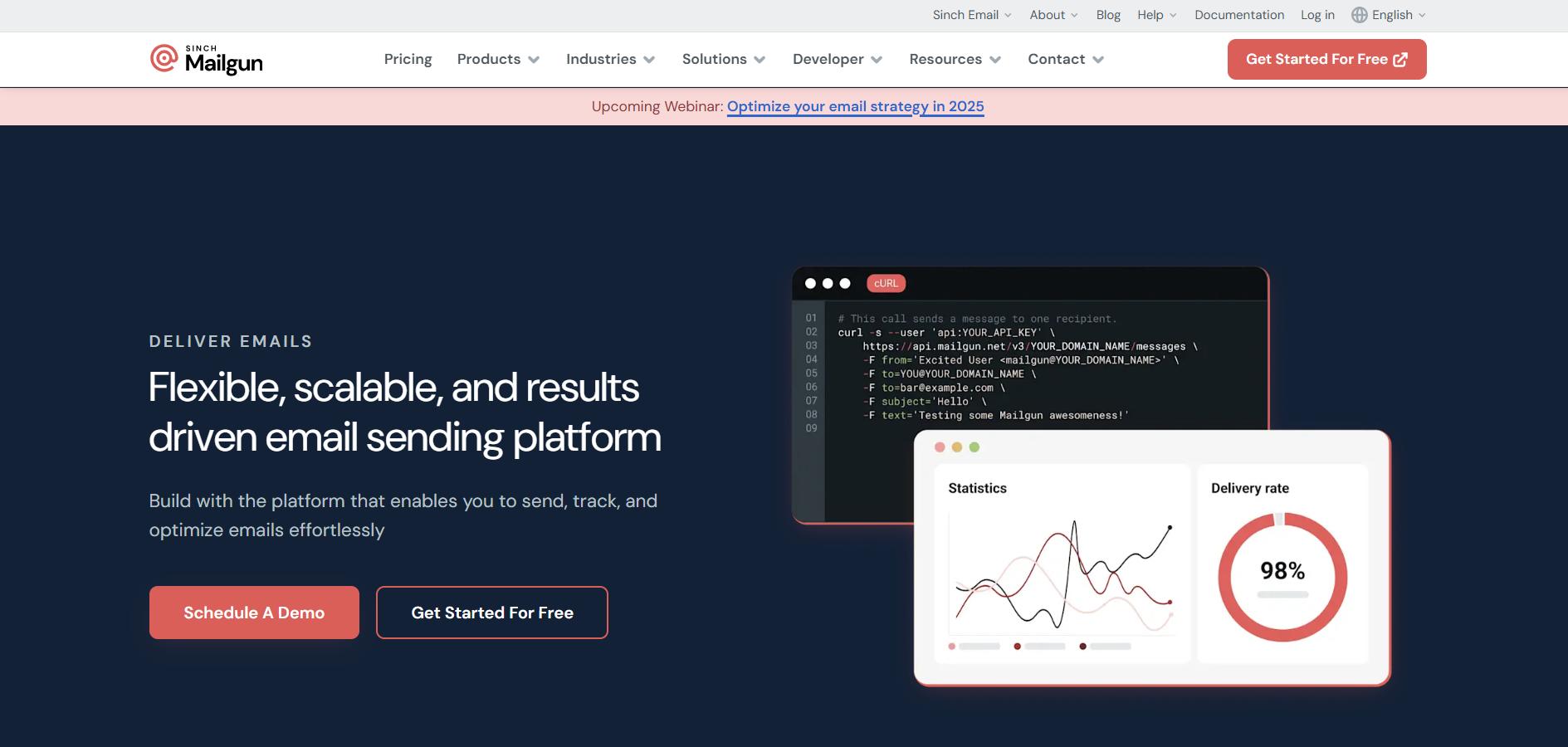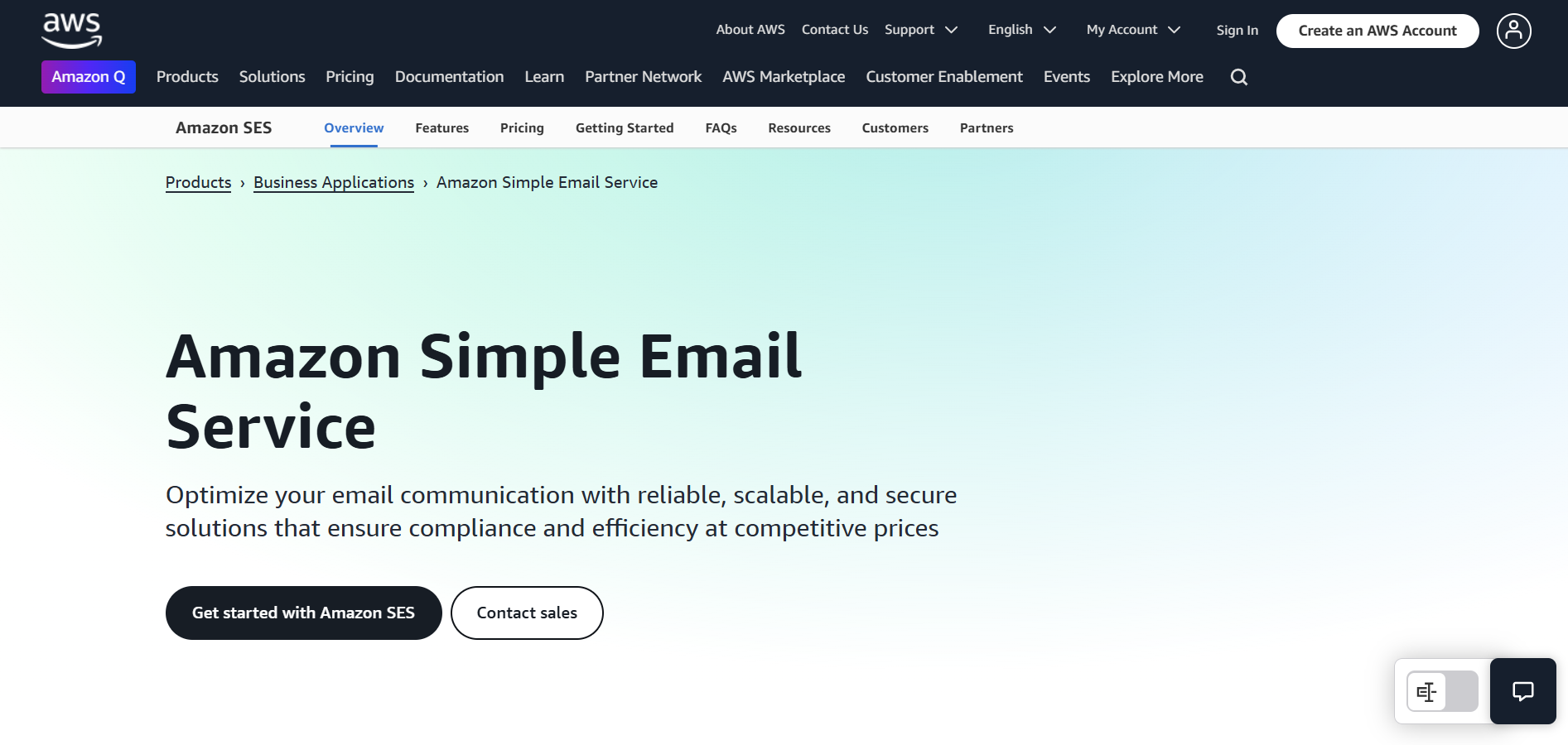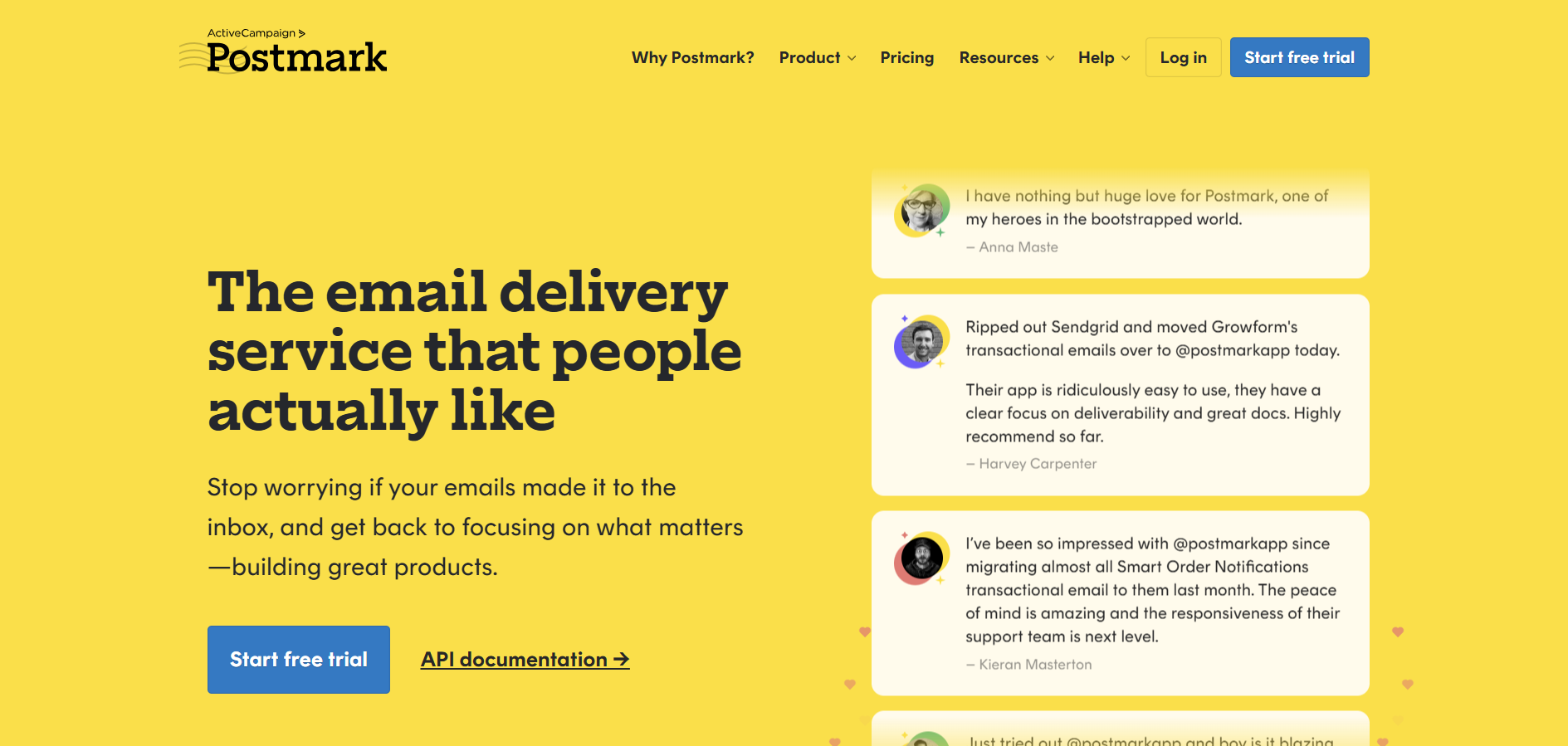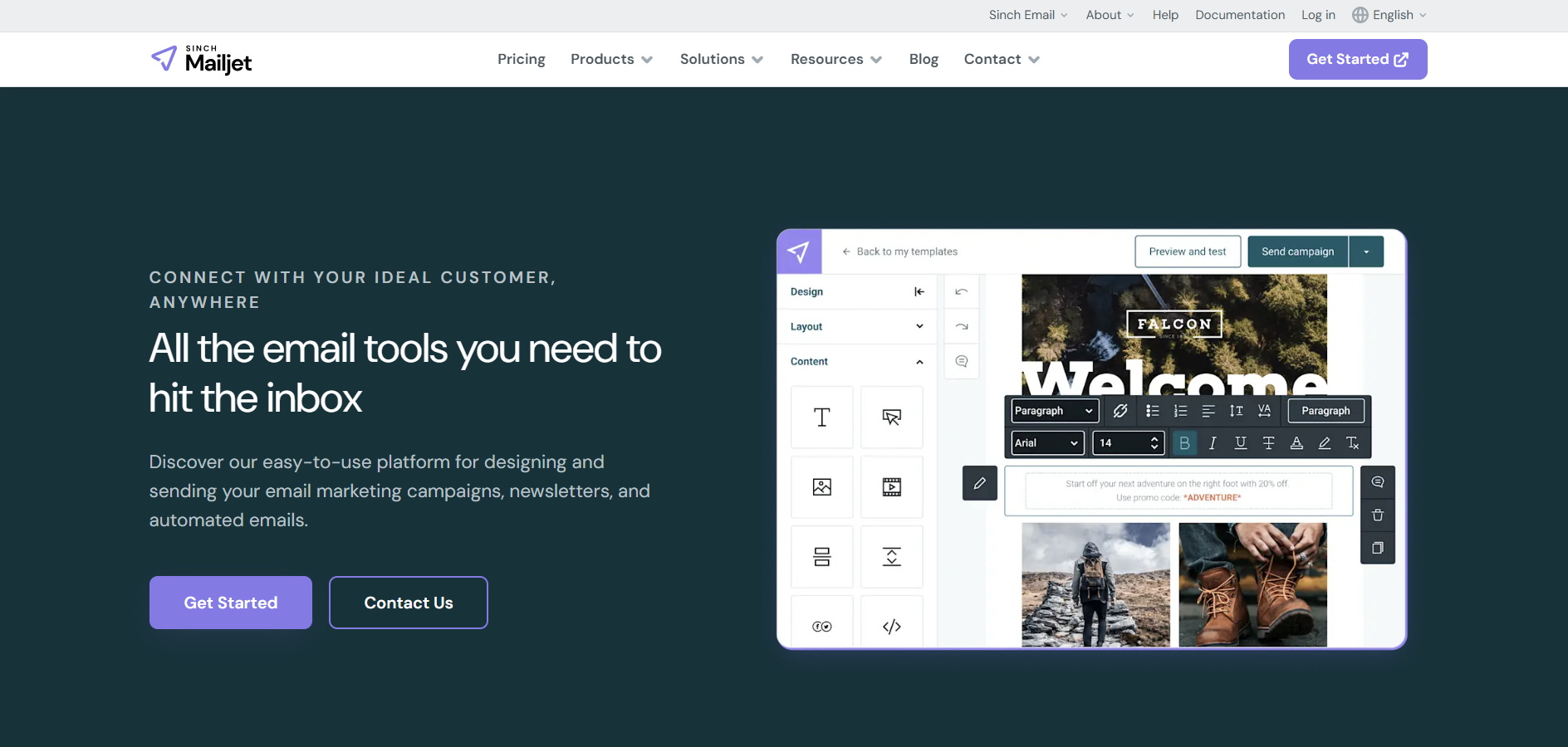Top SendGrid Alternatives for Email Marketing and Transactional Emails
Written by: Hrishikesh Pardeshi, Founder at Flexiple, buildd & Remote Tools.
Last updated: Feb 06, 2025

Best Sendgrid Alternatives in 2025 are:
Mailgun
Amazon SES
Postmark
Mailjet
SparkPost
Zoho Mail
Moosend
In the ever-evolving landscape of email delivery services, finding the right alternative to Sendgrid is crucial for businesses aiming to optimize their email marketing campaigns. Whether you're seeking enhanced deliverability from a transactional email service provider, more flexible pricing from email marketing services, or advanced analytics from an email delivery platform, the alternatives listed below offer a variety of features tailored to meet diverse needs. This guide explores the top Sendgrid alternatives, comparing their strengths and weaknesses to help you make an informed decision for your email operations.
Table of Contents
Why Do You Need Alternatives to Sendgrid?
Exploring alternatives to Sendgrid is essential when your current email service doesn't fully align with your evolving business requirements. Whether it's the need for more competitive pricing, better integration capabilities, enhanced deliverability rates, or specialized features, alternatives can provide tailored solutions that better support your email marketing and transactional communication strategies. By evaluating other platforms, you can ensure that your email operations remain efficient, scalable, and aligned with your organizational goals.
Who Should Consider Using Sendgrid Alternatives?
Identifying the right circumstances for switching to a Sendgrid alternative can significantly impact your email strategy's effectiveness, especially when considering simple mail transfer protocol (SMTP) service and email marketing automation. Whether you're a developer seeking robust API integrations, a marketer focused on advanced analytics and marketing messages, a small business looking for cost-effective solutions with reliable phone support, or an enterprise requiring high deliverability rates across major email clients, there are specific alternatives designed to meet these needs. Understanding who should consider these alternatives, including those concerned with invalid email addresses, helps in selecting the most suitable platform for your unique requirements.
Developers Needing Robust API Integrations
For developers who require comprehensive API capabilities to integrate email services seamlessly into their applications, platforms like Mailgun and Amazon SES provide extensive documentation and flexible APIs that facilitate smooth implementation.
Marketers Focused on Advanced Analytics
Marketers seeking detailed insights and advanced analytics to optimize their email campaigns will benefit from alternatives like Postmark and SparkPost, which offer in-depth reporting and real-time data tracking.
Small Businesses Looking for Cost-Effective Solutions
Small businesses aiming to manage their email communications without breaking the bank can explore options like Mailjet and Moosend, which offer competitive pricing plans and scalable features tailored to growing needs.
Enterprises Requiring High Deliverability Rates
Enterprises that prioritize high deliverability rates and reliable email delivery can consider platforms like Amazon SES and SparkPost, known for their robust infrastructure and strong reputation with email service providers.
Startups Seeking Easy Setup and User-Friendly Interfaces
Startups looking for straightforward setup processes and intuitive user interfaces will find Zoho Mail and Mailgun appealing, as they offer user-friendly dashboards and streamlined onboarding procedures.
Sendgrid Alternatives Comparison Table
| Feature | Mailgun | Amazon SES | Postmark | Mailjet | SparkPost | Zoho Mail | Moosend |
|---|---|---|---|---|---|---|---|
| Ease of Use | Moderate | Moderate | Easy | Easy | Moderate | Easy | Easy |
| Pricing | Free & Paid Plans | Pay-as-you-go | Paid | Free & Paid Plans | Free & Paid Plans | Free & Paid Plans | Free & Paid Plans |
| Platform Support | Browser-based | Browser-based | Browser-based | Browser-based | Browser-based | Browser-based | Browser-based |
| Collaboration Features | Moderate | Moderate | Moderate | Extensive | Extensive | Extensive | Extensive |
| Special Features | Advanced API & Email Validation | AWS Integration | High Deliverability | Drag-and-Drop Builder | Machine Learning Insights | Integrated Productivity Tools | Advanced Automation |
Best Sendgrid Alternatives
Selecting the right alternative to Sendgrid can significantly enhance your email communication strategies. The following platforms offer a range of features from powerful APIs and advanced analytics to user-friendly interfaces and cost-effective pricing. Whether you're a developer, marketer, small business, or enterprise, these alternatives provide solutions tailored to meet your specific email needs. Below is a detailed overview of the top Sendgrid alternatives to consider for your email operations.
1. Mailgun

Mailgun is a powerful email delivery service designed for developers and businesses looking to integrate robust email capabilities into their applications. With its extensive API features and flexible integration options, Mailgun stands out as a top alternative to Sendgrid, particularly for transactional email needs.
Mailgun vs Sendgrid
Mailgun offers a developer-centric approach with powerful APIs and flexible integration options, making it ideal for businesses that require extensive customization and automation in their email workflows. Unlike Sendgrid, which caters to a broader audience including marketers, Mailgun focuses primarily on transactional emails and developer needs.
Key Features of Mailgun
Powerful API for email sending and tracking
Advanced email validation services
Detailed analytics and reporting
Scalable infrastructure for high-volume emails
SMTP integration and webhooks for automation
Mailgun Pros
Developer-friendly with comprehensive documentation
Flexible pricing based on usage
High deliverability rates
Robust email validation to reduce bounces
Seamless integration with various programming languages
Mailgun Cons
Limited features for non-transactional emails
Steeper learning curve for non-developers
Customer support can be slow for lower-tier plans
Advanced features may require higher-tier subscriptions
No built-in email template builder
Mailgun Pricing
Mailgun offers four pricing plans as of February 2025. The Trial plan is free and includes 5,000 emails per month. The Foundation plan costs $35 per month for 50,000 emails. The Scale plan is priced at $90 per month for 100,000 emails. For higher volumes, Mailgun offers a Custom plan with pricing upon request.
2. Amazon SES

Amazon SES is a highly scalable and cost-effective email service designed for businesses that need to send large volumes of emails. With its seamless integration with other AWS services and robust infrastructure, Amazon SES stands out as a reliable alternative to Sendgrid for both transactional and bulk email needs.
Amazon SES vs Sendgrid
Amazon Simple Email Service (SES) is a highly scalable and cost-effective email service designed for businesses that need to send large volumes of emails. Unlike Sendgrid, which offers a more comprehensive suite of marketing tools, Amazon SES focuses on transactional emails and integrates seamlessly with other AWS services.
Key Features of Amazon SES
Pay-as-you-go pricing model
High deliverability with AWS infrastructure
Integration with other AWS services
SMTP and API support for sending emails
Advanced analytics and reporting
Amazon SES Pros
Cost-effective for high-volume email sending
Reliable infrastructure backed by AWS
Flexible integration options
Scalable to handle large email campaigns
Strong security features and compliance
Amazon SES Cons
Complex setup process
Limited support for non-technical users
Basic email templates with limited customization
Customer support primarily available through AWS support plans
Less user-friendly interface compared to Sendgrid
Amazon SES Pricing
Amazon SES pricing in 2025 is based on the volume of emails sent. The service offers a free tier for the first year, allowing up to 3,000 messages monthly. After exceeding this limit, users pay $0.10 per 1,000 emails sent. High-volume senders can get better rates, with prices dropping to as low as $0.02 per 1,000 emails for monthly volumes between 50M-100M.
3. Postmark

Postmark is a specialized email service that focuses exclusively on transactional emails, ensuring high deliverability and rapid delivery times. Designed for businesses that prioritize reliability and speed, Postmark offers a streamlined solution for sending critical emails such as password resets, notifications, and receipts.
Postmark vs Sendgrid
Postmark specializes in transactional emails, ensuring high deliverability and fast delivery times. Unlike Sendgrid, which offers both transactional and marketing email capabilities, Postmark focuses solely on transactional communication, making it ideal for businesses that prioritize reliability and speed in their email operations.
Key Features of Postmark
Fast email delivery with high reliability
Detailed email tracking and analytics
Easy-to-use API and SMTP integration
Template management with dynamic content
In-depth message logs for troubleshooting
Postmark Pros
Exceptional deliverability rates
Quick setup and user-friendly interface
Comprehensive tracking and analytics
Excellent customer support
Focus on transactional emails ensures reliability
Postmark Cons
Limited features for marketing emails
Higher pricing for low-volume users
No built-in email template builder for non-transactional emails
Less flexibility in customization compared to Sendgrid
No free tier available
Postmark Pricing
Postmark's pricing structure as of 2025 includes monthly plans starting at $10 for 10,000 emails and going up to $1,200 for 5,000,000 emails. They also offer a free trial that allows users to send 100 emails per month without providing credit card details. For businesses requiring a dedicated IP address, Postmark charges an additional $50 monthly fee.
4. Mailjet

Mailjet is a comprehensive email solution that caters to both transactional and marketing emails. With its intuitive drag-and-drop email builder and advanced segmentation options, Mailjet provides robust tools for creating, managing, and optimizing email campaigns, making it a versatile alternative to Sendgrid.
Mailjet vs Sendgrid
Mailjet provides a comprehensive email solution that caters to both transactional and marketing emails. Unlike Sendgrid, which has a stronger focus on transactional emails, Mailjet offers robust marketing tools, including a drag-and-drop email builder and advanced segmentation options, making it suitable for businesses looking to manage all their email communications in one platform.
Key Features of Mailjet
Drag-and-drop email builder
Advanced email segmentation and targeting
Real-time collaboration for teams
API and SMTP integration for transactional emails
Comprehensive analytics and reporting
Mailjet Pros
User-friendly interface with intuitive design tools
Flexible pricing plans for different needs
Supports both transactional and marketing emails
Real-time collaboration features for teams
Strong integration capabilities with popular platforms
Mailjet Cons
Limited advanced features in lower-tier plans
Customer support can be slow during peak times
Higher costs for premium features
Some users report deliverability issues
Basic automation features compared to competitors
Mailjet Pricing
Mailjet's pricing includes several tiers. The Essential 15k plan costs $17 per month, while the Premium 15k plan is priced at $27 per month. For higher volumes, the Premium 100k plan is available at $105 per month. Mailjet also offers annual billing options with a 10% discount.
5. SparkPost

SparkPost is renowned for its high deliverability rates and advanced analytics, making it a formidable competitor to Sendgrid. Leveraging machine learning and real-time insights, SparkPost optimizes email delivery and engagement, providing businesses with the tools needed to enhance their email communication strategies.
SparkPost vs Sendgrid
SparkPost is known for its high deliverability rates and advanced analytics, making it a strong competitor to Sendgrid. While both platforms offer robust APIs and scalable email solutions, SparkPost emphasizes real-time analytics and machine learning to optimize email delivery and engagement.
Key Features of SparkPost
Real-time email analytics and reporting
Machine learning-powered deliverability insights
Flexible API and SMTP integration
Advanced segmentation and targeting
Template management with dynamic content
SparkPost Pros
High deliverability rates with advanced optimizations
Comprehensive real-time analytics
Scalable infrastructure for growing businesses
Strong API capabilities for developers
Excellent customer support and resources
SparkPost Cons
Complex pricing structure can be confusing
Steeper learning curve for non-technical users
Limited features in lower-tier plans
Advanced analytics may require higher-tier subscriptions
Interface can be overwhelming for beginners
SparkPost Pricing
SparkPost has three pricing plans as of 2025. The Starter plan is priced at $20 per month, the Premier plan costs $75 per month, and the Enterprise plan requires contacting the vendor for pricing. The Starter plan includes features such as 25,000 emails per day, 2 custom webhooks, and API or SMTP relay.
6. Zoho Mail

Zoho Mail is part of the Zoho suite of applications, offering integrated email solutions that cater to both transactional and business communication needs. With its robust security features and comprehensive collaboration tools, Zoho Mail serves as an all-in-one platform for businesses seeking to streamline their email operations alongside other productivity tools.
Zoho Mail vs Sendgrid
Zoho Mail is part of the Zoho suite of applications, offering integrated email solutions that cater to both transactional and business communication needs. Unlike Sendgrid, which primarily focuses on email delivery services, Zoho Mail provides a comprehensive email hosting platform with additional productivity tools, making it ideal for businesses looking for an all-in-one solution.
Key Features of Zoho Mail
Integrated email hosting with Zoho suite
User-friendly interface with advanced security features
API and SMTP integration for transactional emails
Advanced email filtering and spam protection
Comprehensive collaboration tools like calendars and contacts
Zoho Mail Pros
Integrated with Zoho’s suite of productivity tools
Affordable pricing for businesses of all sizes
Strong security features and compliance
User-friendly interface with easy setup
Reliable customer support
Zoho Mail Cons
Limited advanced email marketing features
Transactional email capabilities are basic compared to Sendgrid
Customization options for templates are limited
Integration with third-party tools can be challenging
Higher-tier plans needed for advanced features
Zoho Mail Pricing
Zoho Mail offers multiple pricing tiers for businesses in 2025. The Free plan supports 5 users with basic features. The Mail Lite plan costs $1 per user monthly when billed annually, providing 5 GB storage per user and essential email features like domain hosting, email routing, and mobile apps. The Mail Premium plan is priced at $4 per user monthly, offering 50 GB storage per user with additional features such as large attachment support (up to 1 GB), email archival, and backup restoration
7. Moosend

Moosend is a comprehensive email marketing platform that also supports transactional emails. With its powerful automation tools and user-friendly interface, Moosend provides businesses with the capabilities to manage both marketing and transactional email campaigns effectively, making it a versatile alternative to Sendgrid.
Moosend vs Sendgrid
Moosend is a comprehensive email marketing platform that also supports transactional emails. While Sendgrid excels in transactional email delivery with robust APIs, Moosend provides a more balanced approach with powerful marketing automation tools, making it suitable for businesses looking to manage both marketing and transactional email campaigns in one place.
Key Features of Moosend
Advanced email automation workflows
Drag-and-drop email editor
Comprehensive analytics and reporting
API and SMTP integration for transactional emails
Personalization and segmentation capabilities
Moosend Pros
Affordable pricing with extensive features
User-friendly interface with intuitive design tools
Powerful automation and personalization options
Strong integration capabilities with various platforms
Reliable customer support and resources
Moosend Cons
Limited features in lower-tier plans
Transactional email capabilities are less robust than Sendgrid
Advanced automation may require higher-tier subscriptions
Email template customization can be restrictive
Deliverability rates may vary based on usage
Moosend Pricing
Moosend provides flexible pricing options starting with a Free Plan that supports up to 1,000 subscribers and includes unlimited emails, signup forms, and basic analytics. The Pro Plan begins at $9 per month, with pricing scaling based on subscriber count. For instance, at 10,000 subscribers, the cost rises to $88 monthly. The Pro Plan includes additional features like landing pages, transactional emails, and an SMTP server. For larger businesses, Moosend offers an Enterprise Plan with custom pricing, featuring dedicated account management, priority support, and advanced reporting.
FAQs on Sendgrid Alternatives
1. What are the top alternatives to Sendgrid?
The top alternatives to Sendgrid include Mailgun, Amazon SES, Postmark, Mailjet, SparkPost, Zoho Mail, and Moosend. These platforms offer diverse features for email delivery, marketing, and transactional communication, catering to businesses and developers of all sizes.
2. Why should I consider using an alternative to Sendgrid?
You should consider using an alternative to Sendgrid if you require features like more flexible pricing, enhanced deliverability rates, advanced analytics, better integration with your existing tools, or specialized functionalities tailored to your specific email communication needs. Exploring alternatives allows you to find a platform that best aligns with your business objectives and technical requirements.
3. Are Sendgrid alternatives free to use?
Many Sendgrid alternatives offer free plans with basic features. For instance, Mailgun provides a free tier for a limited number of emails, Amazon SES has a pay-as-you-go model with low costs, and Moosend offers a free plan for up to 1,000 subscribers. However, most platforms also have premium plans that unlock advanced features like higher email volumes, enhanced analytics, and priority support.
4. Which Sendgrid alternative is best for developers?
For developers, Mailgun and Amazon SES are excellent choices due to their powerful APIs, flexible integration options, and comprehensive documentation. Mailgun is particularly developer-friendly with robust API capabilities, while Amazon SES offers seamless integration with other AWS services, making it ideal for applications hosted on AWS.
5. Can I use Sendgrid alternatives for marketing campaigns?
Yes, many Sendgrid alternatives are well-suited for marketing campaigns. Mailjet and Moosend offer advanced email marketing tools, including drag-and-drop editors, automation workflows, and detailed analytics. These platforms are designed to help businesses create, manage, and optimize their email marketing efforts effectively.